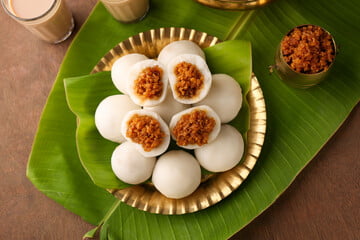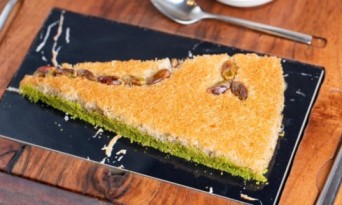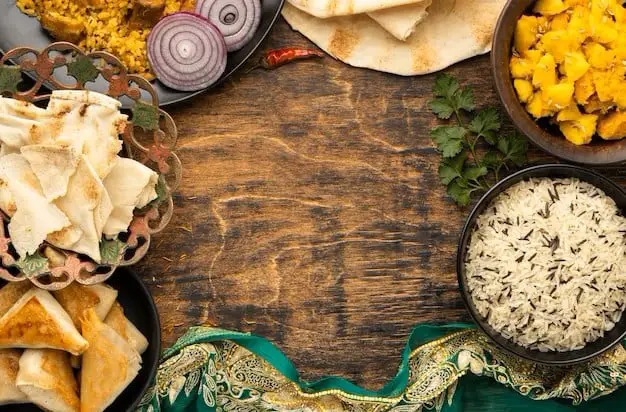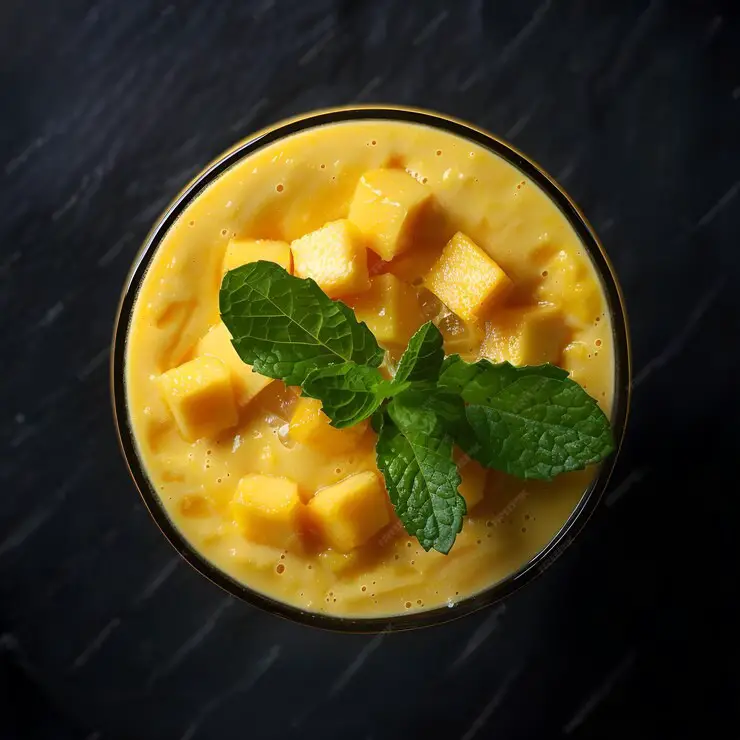
Table of Contents
Introduction:
- Mango Shrikhand is a popular Indian sweet dish that originated in the western Indian states of Maharashtra and Gujarat. It is a refreshing and creamy dessert made by combining strained yogurt (hung curd) with sweetened mango puree and aromatic spices like cardamom and saffron.
- Mango Shrikhand is a popular Indian dessert that captures the essence of summer in every mouthwatering mouthful because to its rich, creamy texture, vivid mango taste, and warm, fragrant spices. It is a beloved treat in the hot summer months and a cherished delicacy at festive events and festivities because it is the ideal balance of indulgence and refreshment.
Ingredients:
Preparing the Yogurt:
- Full-fat yogurt or dahi is used to make shrikhand. The yogurt is strained through a muslin cloth or cheesecloth to remove the whey and obtain a thick, creamy texture.
- The strained yogurt, known as hung curd or chakka, is the base for shrikhand and gives it a rich, velvety consistency.
Mango Puree:
- Ripe, sweet mangoes like Alphonso, Kesar, or Badami are preferred for making the mango puree.
- The mangoes are peeled, chopped, and blended into a smooth puree. Fresh or canned mango puree can be used.
- The mango puree lends a vibrant color, sweet flavor, and fruity aroma to the shrikhand.
Sweetening and Flavoring:
- Sugar is added to the mango puree to balance the tartness and enhance the sweetness.
- Cardamom powder (elaichi) and saffron (kesar) strands are the traditional spices added for their aroma and flavor.
- Some variations also include nutmeg, rose water, or kewra water for additional fragrance.
Garnishing and Serving:
- Shrikhand is often garnished with sliced pistachios, almonds, or charoli seeds (chironji) for texture and visual appeal.
- It is served chilled, making it a refreshing treat, especially during hot summer months.
- Shrikhand can be enjoyed as a dessert, snack, or even for breakfast, sometimes accompanied by puris or crisp breads like ghathiya.
Mango Shrikhand is a beloved Indian dessert that combines the richness of yogurt with the sweet and tangy flavors of mango, creating a delightful and indulgent treat. Its creamy texture, vibrant color, and aromatic spices make it a popular choice for festive occasions and celebrations.
Preparing the Hung Curd:

- The first step is to line a large bowl or colander with a few layers of muslin cloth or cheesecloth. Make sure the cloth is damp so the yogurt doesn’t stick to it.
- Take fresh, full-fat yogurt and pour it into the center of the muslin-lined bowl or colander. Gather the edges of the cloth together and tie them into a knot to form a bundle or bag.
- Hang this bundle over a deep bowl or pot, allowing the whey (the thin, yellowish liquid) to drain out slowly from the yogurt. You can tie the bundle to a wooden spoon or ladle placed across the top of the bowl to suspend it.
- Let the yogurt hang and strain for several hours or preferably overnight in the refrigerator. The longer it hangs, the thicker and richer the hung curd will become as more whey is removed.
- After straining, you’ll be left with a thick, lush, creamy mass in the muslin bundle – this is the hung curd or chakka needed for shrikhand. Untie the knot and transfer the hung curd to a bowl, discarding the drained whey.
- The straining process helps remove excess moisture from the yogurt, resulting in a concentrated, velvety smooth curd with a lush, thick texture perfect for making shrikhand. The cloth helps separate the thick curd solids from the liquid whey.
- You can gently press or squeeze the bundle to extract any remaining whey if needed to get an extra thick hung curd consistency. Be careful not to overwork it.
- The fresh, creamy hung curd is now ready to be blended with mango puree, sugar and spices to create the luscious, indulgent Mango Shrikhand dessert.
Mixing the Shrikhand:
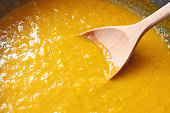
1) In a large clay bowl, add the thick, creamy curd (strained curd). Use a spoon or whisk to lightly loosen and smooth the curd.
2) The mangoes are peeled, chopped, and blended into a smooth puree. Heat the gass and add mango puree, sugar and a little water (so that the sugar does not stick to the pan) and stir well. The amount of sugar can be adjusted according to taste preference. Whisk together until the sugar is completely incorporated into the mango.
3) Add a pinch of cardamom powder to the sweet mango puree and mix well to evenly distribute the hot, aromatic spice.
4) Gently crush a few saffron strands between your fingers and add to the puree mixture. Saffron will reveal its vibrant color and floral notes.
5) Pour the sweet, spicy mango puree over the strained yogurt in a large bowl.
6) Using a whisk or silicone spatula, begin to gently but thoroughly fold the mango puree into the suspended curd. Be careful not to overmix as this can make the mixture grainy.
7) As you fold, the orange-yellow mango puree will slowly blend into the white curd, turning it into a smooth, pale orange mixture with flecks of saffron.
8) Continue folding until the mango and curd are completely combined and homogenous, leaving no lumps. The mixture should be tasty, creamy and well blended.
9) Do a taste test and adjust for sweetness, adding more sugar if necessary. You can add extra cardamom or saffron for a stronger flavor.
- The final Srikhand mixture should have a smooth, velvety texture with the aroma of sweet mango and the tanginess of curd balanced by the warmth of cardamom and saffron.
- Chill the shrikhand well before serving so that the flavors meld and the mixture thickens a bit more. Garnish as desired and enjoy!
Garnishing and Serving:
- Shrikhand is typically garnished with sliced pistachios or almonds for a crunchy contrast and visual appeal.
- It is best served chilled, allowing the flavors to meld and the texture to thicken slightly.
- Mention that it can be enjoyed as a dessert, a sweet snack, or even for breakfast, often accompanied by crisp breads like puris or ghathiya.
Pro Tips and Variations:
- Suggest using ripe, sweet mangoes for the best flavor and texture.
- Mention that canned mango puree can be used as a convenient alternative to fresh mangoes.
- Discuss optional additions like nutmeg, rose water, or kewra water for extra fragrance.
- Offer variations like using different fruits like strawberries or pineapple instead of mangoes.
With its rich, creamy texture, vibrant mango flavor, and aromatic spices, Mango Shrikhand is a beloved Indian dessert that encapsulates the essence of summer in every luscious bite.
Here are some important tips for making the perfect Mango Shrikhand:
- Use full-fat yogurt: For the best texture and richness, it’s crucial to use full-fat yogurt or dahi. Low-fat or non-fat yogurt won’t yield the desired thick, creamy consistency after straining.
- Strain the yogurt thoroughly: Let the yogurt strain for at least 6-8 hours or overnight to remove as much whey as possible. This concentration of solids results in a lush, velvety hung curd.
- Use ripe, sweet mangoes: Select mangoes that are ripe, fragrant, and sweet for the best flavor. Alphonso, Kesar, and Badami varieties work wonderfully.
- Adjust sweetness to taste: The amount of sugar needed can vary based on the sweetness of the mangoes and personal preference. Start with a little less and add more if required.
- Bloom the saffron: Before adding to the mixture, crush the saffron strands lightly between your fingers and let them bloom in a teaspoon of warm milk or water for a few minutes to release their vibrant color and aroma.
- Don’t overmix: When combining the hung curd and mango puree, use a gentle folding motion. Overmixing can cause the mixture to become grainy or lose its luscious texture.
- Chill thoroughly: Once the shrikhand is made, refrigerate it for at least 1-2 hours before serving. This allows the flavors to meld and the mixture to thicken slightly more for the perfect consistency.
- Garnish generously: Top the chilled shrikhand with sliced pistachios, almonds, or charoli seeds (chironji) for a lovely crunch and visual appeal.
- Serve chilled: Mango Shrikhand is best enjoyed well-chilled, making it a perfect refreshing treat, especially during hot summer months.
- Use within a few days: While the shrikhand can be stored in the refrigerator for 3-4 days, it’s best consumed fresh for the best texture and flavor.
Following these tips will ensure that your homemade Mango Shrikhand turns out creamy, luscious, and bursting with the quintessential flavors of sweet mangoes, cardamom, and saffron.
Here are some important FAQs about the Mango Shrikhand recipe:
Q: Can I substitute Greek yogurt for regular yogurt?
A: While Greek yogurt is thicker than regular yogurt, it’s still not ideal for making shrikhand. Greek yogurt has already been strained, so straining it further may result in a dry, overly thick texture. It’s best to use regular full-fat yogurt and strain it yourself to get the perfect hung curd consistency.
Q: My shrikhand turned out grainy. What went wrong?
A: A grainy texture in shrikhand can happen if you overmix the hung curd and mango puree. Be gentle when folding them together, and stop as soon as they are well combined. Overmixing can cause the proteins in the yogurt to become grainy.
Q: Can I use frozen mango puree?
A: Yes, you can use frozen mango puree if fresh mangoes are not in season. Make sure to thaw the puree completely and drain any excess liquid before using it in the recipe.
Q: How can I make shrikhand without saffron?
A: Saffron adds a lovely aroma and color to shrikhand, but it’s not essential. You can skip the saffron if you don’t have it on hand. Alternatively, you can add a few drops of rose water or kewra water for a different floral note.
Q: Can I make shrikhand ahead of time?
A: Shrikhand can be made a day in advance and stored in the refrigerator. However, it’s best to eat it within 2-3 days for the best flavor and texture. If storing, make sure to cover it well to prevent it from drying out or absorbing any odors from the fridge.
Q: What can I use instead of pistachios for garnish?
A: If you don’t have pistachios, you can garnish shrikhand with sliced almonds, chopped cashews, or even dried rose petals. Alternatively, you can skip the garnish altogether and enjoy the shrikhand as is.
Q: How can I make a vegan version of shrikhand?
A: For a vegan version, you can use coconut yogurt or thick coconut milk instead of dairy yogurt. Strain it well to get a thick consistency, and then follow the same process of adding sweetened mango puree and spices.
By addressing these common FAQs, you can troubleshoot any issues and make sure your homemade Mango Shrikhand turns out perfectly every time.
Here is an approximate nutrition list for a serving of Mango Shrikhand:
Nutrition Facts (per serving, based on 4 servings):
Calories: 380
Total Fat: 12g
Saturated Fat: 7g
Trans Fat: 0g
Cholesterol: 35mg
Sodium: 95mg
Total Carbohydrates: 58g
Dietary Fiber: 2g
Total Sugars: 50g
Added Sugars: 25g
Protein: 11g
Vitamin D: 1mcg
Calcium: 280mg
Iron: 0.5mg
Potassium: 450mg
The main sources of nutrients are:
- Fat: Primarily from the full-fat yogurt/hung curd.
- Carbohydrates: Mango puree contributes natural sugars, while added granulated sugar provides a significant portion of the total carbs and added sugars.
- Protein: Provided by the yogurt/hung curd.
- Calcium: A good source from the yogurt.
- Potassium: Mangoes are a decent source of potassium.
A few notes:
- The nutrition data can vary based on the specific ingredients and quantities used.
- Using low-fat or non-fat yogurt will reduce the fat and calorie content.
- Adjusting the amount of added sugar can significantly impact the carbohydrate and sugar levels.
- The garnish of nuts like pistachios or almonds will contribute additional fat, protein, and calories.
While delicious, Mango Shrikhand is a calorie-dense dessert due to its ingredients like full-fat yogurt, mangoes, and added sugar. Moderation is key when indulging in this rich and creamy Indian treat.
Wrapping Up
Mango Shrikhand is really something special. It’s easy to make but tastes fancy. The yogurt is a bit sour, the mango is sweet, and the cardamom smells great. When you mix them all together, it’s super delicious.
You can make this dessert for lots of reasons:
- To impress your friends
- To cool down on a hot day
- To use up extra mangoes
It’s like having a taste of summer in India, no matter where you are or what time of year it is.
Why not try making it? I think you’ll really like it. You might even start making it all the time! Have fun mixing!
Mango Shrikhand | Amrakhand
Mango Shrikhand is a popular Indian dessert that captures the essence of summer in every mouthwatering mouthful because to its rich, creamy texture, vivid mango taste, and warm, fragrant spices. It is a beloved treat in the hot summer months and a cherished delicacy at festive events and festivities because it is the ideal balance of indulgence and refreshment.
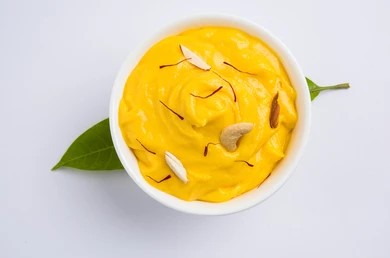
list of ingredients
Instructions
recipe details
-
Preparing the Yogurt:
- The first step is to line a large bowl or colander with a few layers of muslin cloth or cheesecloth. Make sure the cloth is damp so the yogurt doesn't stick to it.
- Take fresh, full-fat yogurt and pour it into the center of the muslin-lined bowl or colander. Gather the edges of the cloth together and tie them into a knot to form a bundle or bag.
- Hang this bundle over a deep bowl or pot, allowing the whey (the thin, yellowish liquid) to drain out slowly from the yogurt. You can tie the bundle to a wooden spoon or ladle placed across the top of the bowl to suspend it.
- Let the yogurt hang and strain for several hours or preferably overnight in the refrigerator. The longer it hangs, the thicker and richer the hung curd will become as more whey is removed.
- After straining, you'll be left with a thick, lush, creamy mass in the muslin bundle - this is the hung curd or chakka needed for shrikhand. Untie the knot and transfer the hung curd to a bowl, discarding the drained whey.
- The straining process helps remove excess moisture from the yogurt, resulting in a concentrated, velvety smooth curd with a lush, thick texture perfect for making shrikhand. The cloth helps separate the thick curd solids from the liquid whey.
- You can gently press or squeeze the bundle to extract any remaining whey if needed to get an extra thick hung curd consistency. Be careful not to overwork it.
- The fresh, creamy hung curd is now ready to be blended with mango puree, sugar and spices to create the luscious, indulgent Mango Shrikhand dessert.
-
Mixing the Shrikhand:
1) In a large clay bowl, add the thick, creamy curd (strained curd). Use a spoon or whisk to lightly loosen and smooth the curd.
2) The mangoes are peeled, chopped, and blended into a smooth puree. Heat the gass and add mango puree, sugar and a little water (so that the sugar does not stick to the pan) and stir well. The amount of sugar can be adjusted according to taste preference. Whisk together until the sugar is completely incorporated into the mango.
3) Add a pinch of cardamom powder to the sweet mango puree and mix well to evenly distribute the hot, aromatic spice.
4) Gently crush a few saffron strands between your fingers and add to the puree mixture. Saffron will reveal its vibrant color and floral notes.
5) Pour the sweet, spicy mango puree over the strained yogurt in a large bowl.
6) Using a whisk or silicone spatula, begin to gently but thoroughly fold the mango puree into the suspended curd. Be careful not to overmix as this can make the mixture grainy.
7) As you fold, the orange-yellow mango puree will slowly blend into the white curd, turning it into a smooth, pale orange mixture with flecks of saffron.
8) Continue folding until the mango and curd are completely combined and homogenous, leaving no lumps. The mixture should be tasty, creamy and well blended.
9) Do a taste test and adjust for sweetness, adding more sugar if necessary. You can add extra cardamom or saffron for a stronger flavor.
-
Garnishing and Serving:
-
- Shrikhand is typically garnished with sliced pistachios or almonds for a crunchy contrast and visual appeal.
-
- It is best served chilled, allowing the flavors to meld and the texture to thicken slightly.
-
- Mention that it can be enjoyed as a dessert, a sweet snack, or even for breakfast, often accompanied by crisp breads like puris or ghathiya.
-




